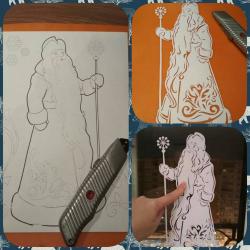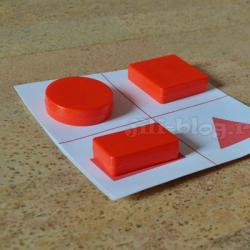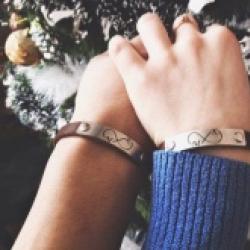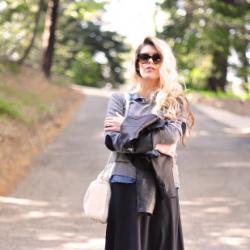When did clothes appear? When clothes appeared (1st class) And England is known for its strict approach
Sections: Primary School
Class: 1
Lesson topic:“When did clothes appear?”
Goals: to introduce children to the history of clothing and the variety of modern clothing.
During the classes.
Look among what beautiful dolls our Ant is. Why are they so beautiful? (Children talk about the clothes of the dolls, discuss the features of the clothes of different dolls).
But what happened to Ant? (The mood has changed). Why? (Got a question). Try to formulate it? (When did clothes appear?)
With Ant we will take a journey into the past to get acquainted with the history of clothing.
A student reads a poem.
So as not to freeze in the cold,
To escape the cold,
A man in any skin
I was ready to wrap up.
He cleaned the skin first,
Fixed it so it wouldn't fall,
And walked in the rain and in the snow
There is a man in this skin.
Let's guess how it all started.
Who do we see? (Primitive man.)
What did these people make clothes from? (From animal skins, since there were no fabrics).
When did these clothes appear? (Very long ago, in ancient times).
Our journey continues.
Where did our Ant end up? (To Ancient Greece).
What are the clothes made of? (From fabric).
This garment (tunic) was made from a large rectangular piece of fabric, which was skillfully wrapped around the body and secured with a brooch on one shoulder or two.
Let's try to dress like the ancient Greeks.
I am showing a piece of fabric. I invite one of the volunteers to dress another student.
And who can tell what Ant is wearing? (In the armor of a knight). This means that there was special clothing for protection in battle. What were these clothes made from? Why?
Times changed, and so did the clothes. The costumes were distinguished by great invention and ingenuity. Feathers, bows, lace collars, fluffy skirts. Elegant clothing emphasized a person’s dignity and beauty.
The ant invites us to continue the journey.
Where did Ant end up? (In our time). What kind of clothes are these? (Modern, business).
Each occasion also has its own clothes.
Define this style? (Sports).
What style is this? (Clothes for home. Home clothes).
But there are times when you can come in any clothes, and the more unusual they are, the better. What are these cases?
Masquerade, carnival. Ant at a masquerade.
Working with the textbook.
Determine where these people live?
Physical education minute.
Determine who is the owner of each suit? (Doctor, clown, military man, policeman).
Consolidation.
Workbook page 33.
Look what the children are wearing? Did they put everything on? What is missing?
Creative work.
( In pairs).
Who clothes all the people? (Fashion designer).
Imagine that you are a fashion designer and you need to release a new collection of clothes.
1.  Sports.
Sports.
2. Homemade.
3. Business.
4. Evening.
5. School.
6. Masquerade.
7. Summer.
8. Working
Exhibition of works.
Bottom line.
Our journey has come to an end. We visited the distant past thanks to Ant and your creativity.
The Wise Turtle asks you a question.
Since when have clothes been around? What new did you learn? (Clothing appeared in ancient times, even among primitive people. They dressed in animal skins. Later, people learned to make fabrics and began to sew clothes).
Presentation for the lesson on the surrounding world, 1st grade of the educational complex “School of Russia”
“When did clothes appear?”

click on the question
Guys, what clothes did you wear when you were very little? How have your clothes changed over time?


Primitive people did
clothing made from animal skins to protect themselves from cold, heat and rain. At first, people simply tied and wrapped the skins around the body. After some time, they learned to tie and weave the skins. Gradually, man learned to process skins and make
their. Clothes became thinner and could cover the entire body.



click on the question
In ancient times, the thread was twisted with fingers. Later, spinning wheels and spindles appeared.
Who wove these threads?

And even later, a spinning machine. And now
The threads are spun, that is, twisted from fibers, by huge spinning machines. Not only cotton threads, but also wool and linen.

Gradually, the man changed from skins to cloth. But these were not the clothes we were used to. Such clothes were worn in Ancient Greece.
It hasn't been sewn yet. They simply took a large rectangular piece of fabric and wrapped it around the body several times. The ends were pinned with a pin. In those countries where it is always hot, such clothes are comfortable.


Time passed, people learned to sew
beautiful outfits, came up with scarves and hats. This was in France.


We see the clothes we wore
400-500 years ago in Rus' there were ordinary people. Both men and women wore loose enough clothing to move comfortably.

Clothes of ordinary people
Women wore a shirt, a sundress, an apron, a soul warmer, a kokoshnik on their heads, and bast shoes on their feet.
Men wore blouse shirts, trousers, a sash (belt), bast shoes with onuchs and frills.

Clothes of ordinary people
In winter, the outerwear of men was a zipun or caftan made of homespun cloth, sheepskin head coats, and boots.
Women wore sheepskin or squirrel fur coats, scarves, shawls, and felt boots.


click on the question
We live in a country where the weather
changes greatly at different times of the year, so in order not to get sick, we are forced to change our clothes depending on the weather.
What are you wearing today? What do you wear in winter? What - in spring and autumn? What - in the summer? Why do you need so many different clothes, is it really impossible to get by with only winter or only summer clothes?

Guys!
Do you want to know what other clothes can be? Then click on the picture on the next slide and read the title.

business
sports
Cloth
home
working


Thank you children
Municipal educational institution secondary school No. 1 Bogoroditsk
Lesson from the world around us
In 1st grade
When did clothes appear?
Primary school teacher
first qualifying
Golovina Elena Nikolaevna

When did clothes appear?


Come on - come on let's try to guess
What can clothes do? as we say.
What would she tell us about then?
There must be a lot of interesting stories
He knows about all the times and customs...
Let the story begin quickly.

It's been a long time... Fashionable outfits
Found by a man in the surrounding nature.
Huge leaves, shaggy skins
They protected the figures from the cold of their ancestors.
Clothes had to be obtained in battle
And every skin was highly valued.


Primitive people did
clothing made from animal skins to protect themselves from cold, heat and rain. At first people just tied
and wrapped the skins around the body. After some time, they learned to tie and weave the skins. Gradually, man learned to process skins and make
their. Clothes became thinner and could
cover your entire body.

As time passed, people learned how to make fabrics. Let's see what the fabric is made of?
Fabric is made up of threads. Let's look at fabrics through a magnifying lens glass: threads are intertwined everywhere! And with some fabrics - gauze, for example, or burlap - this is already visible.


Who wove these threads?
Did it
loom.



And earlier, thousands of years ago, the weaver pulled the transverse thread between the longitudinal ones using a pointed stick.
Hence, by the way, the very word “weaver”: he poked with a stick with a transverse thread, now in one direction, now in the other. If you remove the letter “s” from the word “poke”... You get the word weave!



But people wanted to dress better.
They learned to weave cloth from wool,
And then from cotton, linen and silk
We came up with fabrics. And thread the needle
We thought of putting it in. And for this in the end
They put on tunics, chitons and togas.

Gradually, the man changed from skins to cloth. But these were not the clothes we were used to. Such clothes were worn in Ancient Greece.
It hasn't been sewn yet. They simply took a large rectangular piece of fabric and wrapped it around the body several times. The ends were pinned with a pin. In those countries where it is always hot, such clothes are comfortable.


And England is known for its strict approach.
In an English suit, everything has its place.
Very elegant, yet discreet,
It is made impeccably from striped fabric.
Only the tie complements it solidly,
Everyone can see a gentleman like this from afar.


There have been many costumes in history,
The clothes remember everything. She didn't forget
The greatness of kings, kings, pharaohs,
Glitter, luxury, richness and splendor of styles.
And the discreet dresses of commoners
They go one after another in a single stream.



Previously, men's and women's shirts did not differ in cut. They put them on the body.
Both men and women wore loose enough clothing to move comfortably. But shirts and sundresses had to be belted.
Everyday clothes were most often white, since the fabric was not dyed. In the cold season, they wore zipuns and fur coats, and fur hats on their heads. Hands were protected from the cold with mittens.
The boyars and the tsar wore the same clothes, but they were made from expensive fabrics and had bright colors.

And ladies' dresses are a special topic,
Take anything - not an outfit, but a poem!
A lot of different clothes have been invented for women.
And every dress is like a holiday!
It also has special centuries of signs,
The character of the hostess. But enough about that.

Habits and tastes of different peoples
Their. So they influence fashion.
Fur coats will keep us warm in the cold winter,
But in Africa they will not be able to evaluate them.
Over the centuries, clothing changes noticeably,
Now it is different from the old one.

Let's move on from ancient Russian clothing to modern ones. What are we wearing today? Do clothes differ according to the seasons? What do we wear in winter? What - in spring and autumn? What - in the summer? Why do we need so many different clothes? Can’t we get by with just winter or just summer clothes?
We live in a country where the weather changes greatly at different times of the year, so in order not to get sick, we are forced to change our clothes depending on the weather.


We found out that clothes vary and depend on the weather. What else will influence our choice of clothing?
What groups can clothes be divided into?





But there are also special clothes.
They wear it at work. Some people's profession can be determined by their clothing.










Working from the textbook pp. 20 – 21
Work in the workbook
pp. 15 - 16

Reflection
Today in class I learned...
I liked the task...
Today you can praise …
At home I'll tell you...
This knowledge may be useful in...


The world around us
When did clothes appear?

Look, guys, what dolls we have in our lesson today!
Why are they so beautiful?



Let's try to guess
That clothes, like us, can speak.
What would she tell us about then?
There must be a lot of interesting stories
He knows about all the times and customs...
Let the story begin quickly.

It's been a long time... Fashionable outfits
Found by a man in the surrounding nature.
Huge leaves, shaggy skins
They protected the figures from the cold of their ancestors.
Clothes had to be obtained in battle
And every skin was highly valued.



Where did ancient people live?
What did they make their clothes from? What did they need clothes for?

Primitive people did
clothing made from animal skins to protect themselves from cold, heat and rain. At first people just tied
and wrapped the skins around the body. After some time, they learned to tie and weave the skins. Gradually, man learned to process skins and make
their. Clothes became thinner and could
cover your entire body.





Who wove these threads?
Did it loom .


And earlier, thousands of years ago, the weaver pulled the transverse thread between the longitudinal ones using a pointed stick.
Hence, by the way, the very word “weaver”: he poked with a stick with a transverse thread, now in one direction, now in the other. Remove the letter “s” from the word “poke”... What word did you get? Weave!
Fabric is woven from threads, but where do the threads themselves come from?
Take a piece of cotton wool, wet it and twist it with your fingers, while stretching it a little. What happened? A thread! Not very smooth, really, but real cotton thread. After all, cotton wool is cotton, only purified. Cotton fibers are fleecy, and when you squeezed them with your fingers and even twisted them, they intertwined with their fibers.

Do you know what you did when you twisted short fibers into a long thread? Spinning!
In ancient times, the thread was also twisted with fingers. Then the spindle was invented, and then the spinning machine. And now the threads are spun, that is, twisted from fibers, by huge spinning machines. Not only cotton threads, of course, but also wool and linen.
Woolen threads are spun from wool - most of all from sheep.
But not only sheep provide people with wool. Goats produce very fine wool.



But people wanted to dress better.
They learned to weave cloth from wool,
And then from cotton, linen and silk
We came up with fabrics. And thread the needle
We thought of putting it in. And for this in the end
They put on tunics, chitons and togas.

So, from ancient times we move forward.
Gradually, the man changed from skins to cloth. But these were not the clothes we were used to. Such clothes were worn in Ancient Greece.
It hasn't been sewn yet. They simply took a large rectangular piece of cloth and wrapped it around the body several times. The ends were pinned with a pin. In those countries where it is always hot, such clothes are comfortable. Is it suitable for our country?

Yes, Romans and Greeks had clothes
Simple and convenient. The era has passed.
Age of Knights. Battles, tournaments, campaigns,
Iron helmets, chain mail, surcoats.
And the ladies' dresses are lush and rich.
Tall hats - gennins - horned.




And nearby they fervently fight with swords.
Defeating enemies, as always, with courage.
Daredevil d'Artagnan and friends - musketeers.
Cloaks flutter, spurs rattle.
On felt hats, completing the costume,
Feathers rise. The boots are shining.


And England is known for its strict approach.
In an English suit, everything has its place.
Very elegant, yet discreet,
It is made impeccably from striped fabric.
Only the tie complements it solidly,
Everyone can see a gentleman like this from afar.


There have been many costumes in history,
The clothes remember everything. She didn't forget
The greatness of kings, kings, pharaohs,
Glitter, luxury, richness and splendor of styles.
And the discreet dresses of commoners
They go one after another in a single stream.




Previously, men's and women's shirts did not differ in cut. They put them on the body.
Both men and women wore loose enough clothing to move comfortably. But shirts and sundresses had to be belted.
Everyday clothes were most often white, since the fabric was not dyed. In the cold season, they wore zipuns and fur coats, and fur hats on their heads. Hands were protected from the cold with mittens.
The boyars and the tsar wore the same clothes, but they were made from expensive fabrics and had bright colors.

And ladies' dresses are a special topic,
Take anything - not an outfit, but a poem!
A lot of different clothes have been invented for women.
And every dress is like a holiday!
It also has special centuries of signs,
The character of the hostess. But enough about that.

Habits and tastes of different peoples
Their. So they influence fashion.
Fur coats will keep us warm in the cold winter,
But in Africa they will not be able to evaluate them.
Over the centuries, clothing changes noticeably,
Now it is different from the old one.

Let's move on from ancient Russian clothing to modern ones. What are we wearing today? Do clothes differ according to the seasons? What do we wear in winter? What - in spring and autumn? What - in the summer? Why do we need so many different clothes? Can’t we get by with just winter or just summer clothes?
We live in a country where the weather changes greatly at different times of the year, so in order not to get sick, we are forced to change our clothes depending on the weather.

We found out that clothes vary and depend on the weather. What else will influence our choice of clothing?
What groups can clothes be divided into?


What does "business attire" mean?
What exactly is business attire? Where can you go in business attire? Where do adults go dressed like this?


What does "sportswear" mean? What kind of sportswear do you have?
On what occasions do you wear it?





But there are also special clothes.
They wear it at work. Some people's profession can be determined by their clothing.










http://s43.radikal.ru/i100/0902/9e/66a017deaddd.jpg
http://news.vl.ru/add_files/big328.jpg
http://znaite.com.ua/data/66_item_pict_map.jpg
http://ooostekton.ru/uploads/img/144541189515076.jpg
http://www.aronatour.ru/spain_resorts/spain/sol/hotels/sol_principe06.jpg
http://www.infoorel.ru/view.php?id=201932
http://ov-style.ru/gall/narodnyi/narodnyi-kostym-w3-500.jpg
http://www.gov.karelia.ru/cgi-bin/photo/i.pl?id=5278&s=b
http://www.cofe.ru/images/pictures/read-ka/warriors/Mushket.jpg
http://www.pledo.ru/images/Fabrika/tkatckij_tceh_3.jpg
http://www.emc.komi.com/02/15/img/154.jpg
http://www.medclipart.ru/albums/userpics/10001/normal_medclipart_0701.JPG
http://www.olish.ru/picture/black.gif
http://shkolniki.at.ua/_pu/20/86887003.jpg
http://www.moda-history.ru/files/egypt_costume/210309/3.jpg
http://philosopher27.files.wordpress.com/2009/10/102809_2305_goodnewsand1.png
http://img1.liveinternet.ru/images/attach/c/0/31/377/31377127_725.jpg
http://rexmen.ru/uploads/posts/2010-01/1262569786_rexmen.ru_rizari.jpg
http://www.artsides.ru/big/item_5151.jpg
http://www.interfacetravel.com/images/africa.gif
http://img0.liveinternet.ru/images/attach/c/0/43/855/43855580_1242425620_6.jpg
Slide 2
Puzzles
- Today in class we will continue to answer the question “when”. But what we will learn about today, you will find out when you solve the riddles.
- A fluffy snowdrift, I climbed into it - and it was warm, I clung to my body, and sheltered me from the frost.
- The path is sewn - tied and tied to the house. The house will run around, And then it will freeze - it lies, Guards the house, Drives away the cold
- Wide and thin, it inflates its sides, it rides on me all day. He sits without getting down, and when night comes, he curls up and sleeps.
- House for the head.
Slide 4
- Why did clothes begin to change?
- Do you think the purpose of clothing has changed?
- Why does a modern person need so many clothes? How does he use clothes?
- What kind of clothes does a modern person wear?
- Is the wardrobe of a modern person varied or monotonous?
Slide 5
FUNCTIONALITY
What groups can the clothing of a modern person be divided into depending on its purpose?
Slide 6
We learned so much today about clothes. Would you like to try to create clothes yourself? How could we become clothing creators in class now?
What goals have you set for yourself? Have we achieved our goal? What did we learn about in class today? Whose answers deserved an excellent grade?
Even the most famous designers and clothing designers first mentally imagine a new model, then depict the details on paper, that is, make a sketch, and then sew it from fabric.






